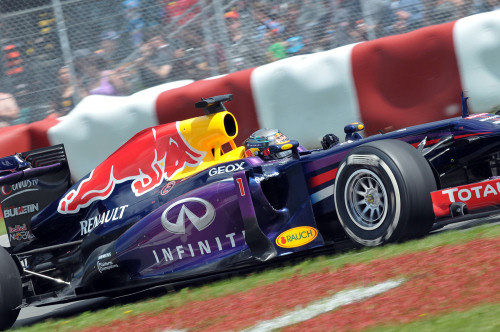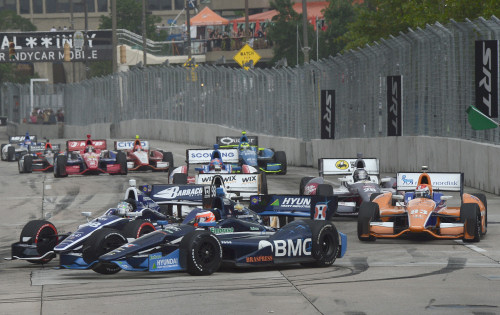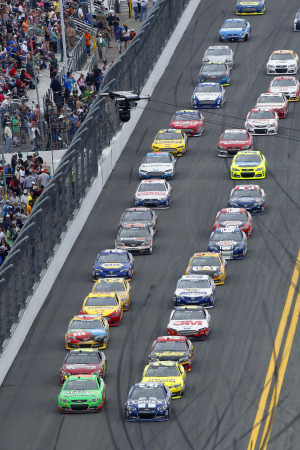The Way It Is/ Losing our wayby Gordon Kirby |
 It struck me one night in October while watching the Red Sox win the World Series. All of baseball's historic majesty and appeal waxed lyrically through the winning game at Fenway Park and it drove home to me how little baseball has changed over the last 100 years.
It struck me one night in October while watching the Red Sox win the World Series. All of baseball's historic majesty and appeal waxed lyrically through the winning game at Fenway Park and it drove home to me how little baseball has changed over the last 100 years.
It's still a guy with a bat, a ball and glove, as it is with the vast majority of sports--football, basketball, soccer, tennis, golf, et al. The rare exceptions are automobile, motorcycle and yacht racing where technology has completely transformed every aspect of these sports. In automobile racing in particular it's long been impossible to see the driver working the wheel, shifting gears, and bending into the corner aboard his machine. We've lost any sense of seeing a skilled athlete in action. People in motor racing have always celebrated new technology, innovation and change. Through most of the last hundred years new thinking and new ways of designing and building the cars and engines were essential ingredients in the sport. Always the burning question was: What's new this year?  © Gary Gold One of the reasons motorcycle racing retains its popularity is because we can see the rider doing his thing and it's clearly a very daring and athletic endeavor. But in car racing it's difficult for the spectator to appreciate the driver's skills or performance as an athlete. What the fans witness today with the drivers swathed in firesuits, gloves and helmets and ensconced inside their modern survival cells is far removed from the spectacles that appealed to the public fifty or a hundred years ago. As I said at the beginning, motor racing is unlike other sports in this way and the result is racing's appeal and role in the public's imagination has changed substantially. Whether or not that's a critical failing remains open to debate, but many people believe it may be. Of course, we're not going to turn back the clock and return to front engine cars running on skinny tires without any aerodynamic aids and the driver sitting out in the wind, elbows flailing as he works a giant, old-fashioned steering wheel. Those days are long gone. Nevertheless, the questions linger. Can anything be done to return to the sport's roots? And is it desirable or necessary to try to go down that route when technology has changed so much over the last hundred years? Motor sport as a whole across America and around the world enjoys a bigger and wider participant base than ever. There are more forms of motor sport and more competitors than ever, but America's traditional major forms of open wheel and sports car racing are withering on the vine.  © Dan Boyd But in today's world of spec cars and highly restrictive rule books such hopes seem foolish. Where ever you turn in American open-wheel, sports car or stock car racing, the sport has taken a different path over the last fifteen or twenty years than many of us would have preferred. IndyCar is struggling to build both its TV ratings and a stronger, more stable and more popular schedule of races. With Dan Andersen at the helm, IndyCar also hopes to rebuild and reinvigorate its ladder system. As we all know, Mark Miles, Derrick Walker and their team have plenty of work on their plates. The new Tudor United SportsCar series is searching for the right technical formula for its inaugural season and looks likely to face a rocky few years on the road to stability. Despite continual talk about working with Le Mans and the ACO it appears that the TUSC and the World Endurance Championship are taking very different paths with the WEC moving to an energy-based formula and continuing to encourage major manufacturers to build and race high-tech, high-performance P1 cars. As the WEC embraces the future and new technology, the TUSC is in danger of becoming a provincial backwater.  © Autostock Still, everyone in NASCAR worries about the future and how to attract younger, more diverse fans. If it's to thrive in the future NASCAR may discover that it has to rethink its commitment to antique, tube-framed V-8-powered cars and to incremental rather than revolutionary change. Meanwhile, it's difficult to predict Formula One's future in the slowly but inevitably approaching post-Bernie Ecclestone era. Today, F1 continues to represent the pinnacle of the sport. The cars are high-tech in rather bizarre ways, but they are very slickly presented and spectacular to watch and hear, and whatever you think of Ecclestone he certainly built F1 over the last thirty years into one of the world's leading global sports. F1 should have a roaring future but the business model Ecclestone created may be broken and as his grip on the sport recedes the political and power struggles within the FIA and among the F1 team owners and manufacturers may make F1 impossible to govern in the future. For sure it's been a good thing for F1 as a whole and for racing in general in America to see big crowds at the first two US Grands Prix at the Circuit of the Americas. Everyone from drivers to spectators seem to enjoy the track and the city of Austin and the race appears to have a healthy future. CotA is attempting to build a full schedule of races of all types and it will be interesting to see how successful Austin can be as an all-round motor racing venue beyond F1. As for Weehawken, hopes remain for 2015 but skepticism abounds. If nothing else, CotA proves that with the proper financial backing and the right formula and management, good things can happen. Would that the same spirit of reinvention could take hold of IndyCar, TUSC and NASCAR and push them forward into brighter, more relevant futures. |
Auto Racing ~ Gordon Kirby Copyright 2013 ~ All Rights Reserved |
